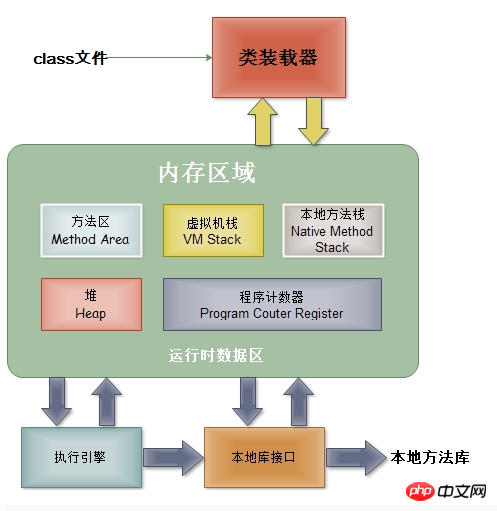JVM (Java Virtual Machine) A specification for computing devices that can be implemented in different ways (software or hardware). Next, this article will give you a brief introduction to the Java JVM virtual machine operating mechanism. Friends who are interested should take a look together
1: Basic concepts of JVM
JVM (Java Virtual Machine) A specification for computing devices that can be implemented in different ways (software or hardware). Compiling the instruction set for a virtual machine is very similar to compiling the instruction set for a microprocessor. The Java virtual machine includes a set of bytecode instructions, a set of registers, a stack, a garbage collection heap and a storage method field.
The Java Virtual Machine (JVM) is an imaginary computer that can run Java code. As long as the interpreter is ported to a specific computer according to the JVM specification, any compiled Java code can be guaranteed to run on that system.
Let’s look at the architecture diagram of Jvm:

##2: The connection and difference between interpreted languages and compiled languages.
Compiled language uses a compiler to compile the program into machine code that can be recognized by the target machine, while interpreted language does not require a compilation process, and the script is read by the interpreter of the language. , interpret according to the grammar rules, and then call the built-in command of the interpreter (or libraryfunction). For example, after the printf() function of C language is compiled statically, all the codes required for printf() are written into the executable file in the form of machine code, and the shell executes When running a program, search for the file in the specified path , and then the loader (Loader) loads the ELF file of the program into the memory, jumps to the program entry, and hands over control to the program.
The situation with dynamic compilation is somewhat different. Since printf() is a very commonly used function, the system collectscommonly used functions into a library. When I write a Myprintf() function and call printf(), the ELF file formed after dynamic compilation will not Contains code related to printf(), but there will be some information telling the system: "My program will call printf(), so I need the address of printf()." After loading the ELF file, first run the dynamic connector (ldd). ldd knows the dynamic library that the program depends on. If the dynamic library is not loaded in the system, it will notify the system to load the library and bind the entry address of the library function to the program. Where needed, then jump to the program entry address and start running the program. Here, once the program we write is compiled, it becomes the machine code of a specific machine and some ancillary information (symbol table, address, variablevalue, etc.), and then becomes "dynamic" through the system loading and running mechanism. "Procedure" - process.
The execution process of interpreted languages is inseparable from the interpreter,python, perl, ruby, etc. So the first line of the script is usually #/usr/bin/×××. ××× represents the corresponding interpreter for each language. Scripts generally consist of expression(expression) and Block of expressions. The first thing the interpreter has to do is to analyze and understand the expression structure to form an "execution sequence". This "execution sequence" is neutral and does not target any native machine, so its "portability" is high. The reason why "bytecode" is not used instead of "execution sequence" here is because there is a concept of bytecode in jvm, and there is a significant difference between them. Determining the execution sequence is the most important role of the interpreter. Assume that the function output by python is python_print(), then when the python interpreter encounters this expression when "interpreting" the script, it will call the system's print() function to perform the output operation. You can also understand the script as an advanced configuration file. This file instructs the python interpreter on how to run. Several rules on "how" to run have been formulated inside the interpreter.
3: Java execution process
JVM execution of Java programs is more complicated than the above two, because it is already called a machine. The figure below is the structural block diagram of the JVM. Mainly includes: garbage collector, class loading subsystem, execution engine, runtime data area, etc.The above is the detailed content of Detailed explanation of Java JVM virtual machine operating mechanism. For more information, please follow other related articles on the PHP Chinese website!